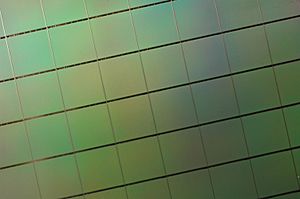WIYN Observatory facts for kids
Template:Infobox vcard
The WIYN Observatory is a special place where scientists use a powerful telescope to study the stars and planets. It is owned and run by a group called the WIYN Consortium.
The main telescope at WIYN is 3.5 meters wide. This makes it the second largest optical telescope at the Kitt Peak National Observatory in Arizona. Many of the costs for building the observatory were paid by the University of Wisconsin–Madison, Indiana University, and Yale University. The National Optical Astronomy Observatory (NOAO) helps keep it running. NOAO is a program in the United States that supports many telescopes, including WIYN.
Contents
The WIYN Telescope
The WIYN telescope is a type called a Ritchey–Chrétien telescope. It sits on a special stand called an altitude-azimuth mount. This mount helps the telescope move up, down, and all around to point at different parts of the sky.
The main mirror of the telescope is almost 3.5 meters wide. It was made at the Richard F. Caris Mirror Lab. This mirror is very important because it collects light from faraway objects in space. To keep the mirror working perfectly, it has 66 special parts called active optics that can gently adjust its shape.
The telescope is housed inside a unique building shaped like a half-Rhombicuboctahedron. This shape helps protect the telescope and its delicate instruments.
Tools for Discovery
The WIYN Observatory uses several amazing tools to help scientists learn about the universe.
Hydra Spectrograph
Hydra is a cool tool that uses tiny fiber optics to look at many different objects in space at the same time. Imagine being able to observe 100 stars or galaxies all at once! Hydra does this by robotically positioning these fibers to collect light from each object.
The light then travels through the fibers to a special room below the telescope. Here, a CCD camera records the light, turning it into a spectrum. A spectrum is like a rainbow of light that tells scientists what an object is made of and how it is moving. Hydra has been helping scientists since 1990.
NEID Planet Hunter
NEID is a very precise tool that helps scientists find planets outside our solar system, called exoplanets. It does this by looking for tiny wobbles in stars. These wobbles are caused by the gravity of planets orbiting them.
NEID can measure these wobbles with incredible accuracy, like measuring how fast a person walks if they move only 50 centimeters per second! This helps scientists figure out the size and weight of exoplanets found by other telescopes, like the TESS space telescope. The name NEID means "to see" in the Tohono Oʼodham language.
NEID was built at Pennsylvania State University and started working in 2021. The Texas Advanced Computing Center (TACC) also helps by providing powerful computers to analyze the data and search for new exoplanets.
One Degree Imager (ODI)
The One Degree Imager, or ODI, is a camera that takes very wide and clear pictures of the sky. It can capture an area of the sky that is about one square degree wide. This is a large area, allowing scientists to see many objects at once.
ODI uses special sensors called Orthogonal Transfer Arrays (OTAs). These sensors can make images even sharper by correcting for tiny movements during the picture-taking process. This makes ODI a unique tool for large sky surveys. ODI started taking pictures in 2013 and was upgraded in 2015 to be even better.
WIYN High Resolution InfraRed Camera (WHIRC)
WHIRC is a camera that takes pictures using infrared light. Infrared light is a type of light that we can't see with our eyes, but it's very useful for looking through dust clouds in space or studying cooler objects.
WHIRC was added to the telescope in 2008. It can take very detailed, high-resolution images. It also works with another tool called the WIYN Tip/Tilt Module (WTTM) to make the images even clearer.
How WIYN is Managed
The WIYN Consortium is run by a board of directors. This board includes three people from each of the universities and organizations that are part of the consortium. They meet twice a year to make important decisions about the observatory.
A group of scientists called the Science Steering Committee also helps guide the observatory's research.
Over the years, some partners have changed. For example, Yale University left the consortium in 2014 and was replaced by the University of Missouri. Also, a partnership between NASA and the National Science Foundation, called NN-EXPLORE, now helps manage the observatory's operations.
See Also
- List of astronomical observatories
- List of largest optical reflecting telescopes
- List of the largest optical telescopes in the contiguous United States
Images for kids



